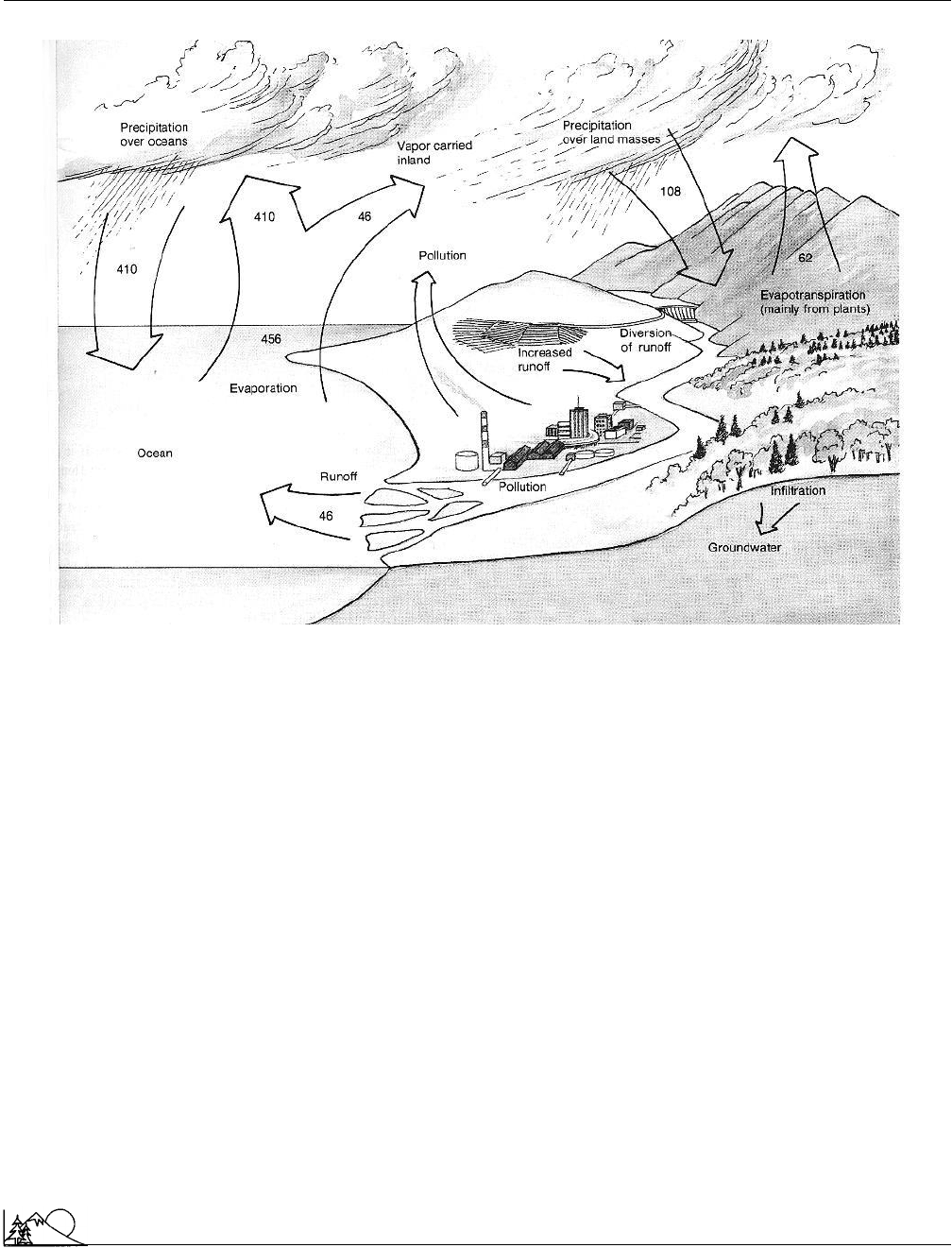Environmental Encyclopedia
Подождите немного. Документ загружается.


Environmental Encyclopedia 3
Hydrocarbons
occasionally. To meet this need, Honda introduced a hybrid-
engine version of its popular Civic line in 2002. With four
doors and ample space for four adults plus a reasonable
amount of luggage. The 5-speed manual version of the Civic
hybrid gets 48 mpg in both city and highway driving. With
a history of durability and consumer satisfaction in other
Honda models, and a 10-year warranty on its battery and
drive train, the hybrid Civic appears to offer the security
that consumers will want in adopting this new technology.
Toyota also has introduced a hybrid vehicle called the
Prius. Similar in size to the Honda Civic, the Prius comes
in a four-door model with enough room for the average
American family. During most city driving, it depends only
on its quiet, emission-free, electric motor. The batteries
needed to drive the 40-hp are stacked up behind the back
seat providing a surprisingly large trunk for luggage. The
70-hp, 1.5 liter gas engine kicks in to help accelerate or
when the batteries need recharging. Getting about 52 mpg
(22 km/l) in city driving, the Prius is one of the most efficient
cars on the road and can travel more than 625 mi (1,000
km) without refueling. Some drivers are unnerved by the
noiseless electric motor. Sitting at a stoplight, it makes no
sound at all. You might think it was dead, but when the
light changes, you glide off silently and smoothly.
Introduced in Japan in 1997, the Prius sells in the
United States for about the same price as the Honda hybrids.
The
Sierra Club
estimates that in 100,000 mi (160,000 km),
a Prius will generate 27 tons of CO
2
, a Ford Taurus will
generate 64 tons, while the Ford Excursion SUV will pro-
duce 134 tons. In 1999, the Sierra Club awarded both the
Insight and the Prius an “excellence in engineering” award,
the first time this organization has ever endorsed commercial
products.
Both Ford and General Motors (GM) have announced
intentions to build hybrid engines for their popular sport
utility vehicles and light trucks. This program may be more
for public relations, however, than to save fuel or reduce
pollution
. The electrical generators coupled to engines of
these vehicles will produce only 12 volts of power. This is
far less than the 42 volts needed to provide drive the wheels.
Instead, the electricity generated by the gasoline-burning
engine will only be used to power accessories such as video
recorders, computers, on-board refrigerators, and the like.
Having this electrical power available will probably actually
increase fuel consumption rather than reduce it. For uncriti-
cal consumers, however, it provides a justification for contin-
uing to drive huge, inefficient vehicles.
In 2002, President G. W. Bush announced he was
abandoning the $1.5 billion government-subsidized project
to develop high-mileage gasoline-fueled vehicles started with
great fanfare eight years earlier by the Clinton/Gore admin-
istration. Instead, Bush was throwing his support behind a
737
plan to develop hydrogen-based
fuel cells
to power the
automobiles of the future. Fuel cells use a semi-permeable
film or electrolyte that allows the passage of charged atoms,
called ions, but is impermeable to electrons to generate an
electrical current between an anode and cathode.
A fuel cell run on pure oxygen and
hydrogen
produces
no waste products except drinkable water and radiant heat.
Fossil fuels
can be used as the source for the hydrogen,
but some pollutants are released (most commonly
carbon
dioxide
) in the process of hydrogen generation. Currently,
the fuel cells available need to be quite large to provide
enough energy for a vehicle. Fuel cell-powered buses and
vans that have space for a large power system are currently
being tested, but a practical, family vehicle appears to be
years away.
While they agree that fuel cells offer a wonderful op-
tion for cars of the future, many environmentalists regard
putting all our efforts into this one project to be misguided
at best. It probably will be at least a decade before a fuel-
cell vehicle is commercially available.
[William P. Cunningham Ph.D.]
R
ESOURCES
B
OOKS
Hodkinson, Ron, and John Fenton. Lightweight Electric/Hybrid Vehicle
Design. Warrendale, PA: Society of Automotive Engineers, 2001.
Jurgen., Ronald K., ed. Electric and Hybrid-electric Vehicles. Warrendale,
PA: Society of Automotive Engineers, 2002.
Koppel, Tom. Powering the Future: The Ballard Fuel Cell and the Race to
Change the World. New York: John Wiley & Sons, 1999.
P
ERIODICALS
“Dark Days For Detroit—The Big Three’s Gravy Train in Recent Years—
Fat Profits from Trucks—is Being Derailed by a New Breed of Hybrid
Vehicles from Europe and Japan.” Business Week, January 28, 2002, 61.
Ehsani, M., K. M. Rahman, and H. A. Toliyat. “Propulsion System Design
of Electric and Hybrid Vehicles.” IEEE Transactions on Industrial Electronics
44 (1997): 19.
Hermance, David, and Shoichi Sasaki. “Special Report on Electric Vehi-
cles—Hybrid Electric Vehicles take to the Streets.” IEEE Spectrum 35
(1998): 48.
Jones, M. “Hybrid Vehicles—The Best of Both Worlds?” Chemistry and
Industry 15 (1995): 589.
Maggetto, G. and J. Van Mierlo. “Fuel cells: Systems and applications—
Electric vehicles, hybrid vehicles and fuel cell electric vehicles: State of the
art and perspectives.” Annales de chimie—science des mate
´
riaux. 26 (2001): 9.
Hydrocarbons
Any compound composed of elemental
carbon
and
hydro-
gen
, hydrocarbons may also contain
chlorine
, oxygen,
nitro-
gen
, and other atoms. Hydrocarbons are classified according
to the arrangement of carbon atoms and the types of chemical
bonds. The major classes include aromatic or carbon ring

Environmental Encyclopedia 3
Hydrochlorofluorocarbons
compounds, alkanes (also called aliphatic or paraffin) com-
pounds with straight or branched chains and single bonds,
and alkenes and alkynes with double and triple bonds, respec-
tively. Most hydrocarbon fuels are a mixture of many com-
pounds.
Gasoline
, for example, includes several hundred
hydrocarbon compounds, including paraffins, olefins, and
aromatic compounds, and consequently exhibits a host of
possible environmental effects. All of the
fossil fuels
, includ-
ing crude oils and
petroleum
, as well as many other com-
pounds important to industries, are hydrocarbons. Hydro-
carbons are environmentally important for several reasons.
First, hydrocarbons give off
greenhouse gases
, especially
carbon dioxide
, when burned and are important contrib-
uters to
smog
. In addition, many aromatic hydrocarbons and
hydrocarbons containing halogens are toxic or carcinogenic.
Hydrochlorofluorocarbons
The term hydrochlorofluorocarbon (HCFC) refers to halo-
genated
hydrocarbons
that contain
chlorine
and/or fluo-
rine in place of some
hydrogen
atoms in the molecule.
They are chemical cousins of the
chlorofluorocarbons
(CFCs), but differ from them in that they have less chlorine.
A special subgroup of the HCFCs is the hydrofluorocarbons
(HFCs), which contain no chlorine at all.
A total of 53 HCFCs and HFCs are possible.
The HCFCs and HFCs have become commercially
and environmentally important since the 1980s. Their grow-
ing significance has resulted from increasing concerns about
the damage being done to stratospheric
ozone
by CFCs.
Significant production of the CFCs began in the late
1930s. At first, they were used almost exclusively as refriger-
ants. Gradually other applications—especially as
propel-
lants
and blowing agents—were developed. By 1970, the
production of CFCs was growing by more than 10% per
year, with a worldwide production of well over 662 million
lb (300 million kg) of one family member alone, CFC-11.
Environmental studies began to show, however, that
CFCs decompose in the upper
atmosphere
. Chlorine
atoms produced in this reaction attack ozone molecules (O
3
),
converting them to normal oxygen (O
2
). Since stratospheric
ozone provides protection for humans against solar
ultravio-
let radiation
, this finding was a source of great concern.
By 1987, 31 nations had signed the Montreal Protocol,
agreeing to cut back significantly on their production of
CFCs.
The question became how nations were to find substi-
tutes for the CFCs. The problem was especially severe in
developing nations where CFCs are widely used in refrigera-
tion and air-conditioning systems. Countries like China and
India refused to take part in the CFC-reduction plan unless
738
CHF
3
HFC-23
CHCl
2
CF
3
HCFC-123
CH
2
FCClF
2
HCFC-133b
CH
3
CHClF HCFC-151a
developed nations helped them switch over to an equally
satisfactory substitute.
Scientists soon learned that HCFCs were a more be-
nign alternative to the CFCs. They discovered that com-
pounds with less chlorine than the amount present in tradi-
tional CFCs were less stable and often decomposed before
they reached the
stratosphere
. By mid 1992, the United
States
Environmental Protection Agency
(EPA) had se-
lected 11
chemicals
that they considered to be possible
replacements for CFCs. Nine of those compounds are HFCs
and two are HCFCs.
The HCFC-HFC solution is not totally satisfactory,
however. Computer models have shown that nearly all of
the proposed substitutes will have at least some slight effect
on the ozone layer and the
greenhouse effect
. In fact,
the British government considered banning one possible
substitute for CFCs, HCFC-22, almost as soon as the com-
pound was developed. In addition, one of the most promising
candidates, HCFC-123, was found to be carcinogenic in
rats.
Finally, the cost of replacing CFCs with HCFCs and
HFCs is expected to be high. One consulting firm, Metroe-
conomica, has estimated that CFC substitutes may be six
to 15 times as expensive as CFCs themselves. See also Aero-
sol; Air pollution; Air pollution control; Air quality; Carcin-
ogen; Ozone layer depletion; Pollution; Pollution control
[David E. Newton]
R
ESOURCES
P
ERIODICALS
Johnson, J. “CFC Substitutes Will Still Add to Global Warming.” New
Scientist 126 (April 14, 1990): 20.
MacKenzie, D. “Cheaper Alternatives for CFCs.” New Scientist 126 (June
30, 1990): 39–40.
Pool, R. “Red Flag on CFC Substitute.” Nature 352 (July 11, 1991): 352.
Stone, R. “Ozone Depletion: Warm Reception for Substitute Coolant.”
Science 256 (April 3, 1992): 22.
Hydrogen
The lightest of all chemical elements, hydrogen has a density
about one-fourteenth that of air. It has a number of special
chemical and physical properties. For example, hydrogen

Environmental Encyclopedia 3
Hydrologic cycle
has the second lowest boiling and freezing points of all
elements. The
combustion
of hydrogen produces large
quantities of heat, with water as the only waste product.
From an environmental standpoint, this fact makes hydrogen
a highly desirable fuel. Many scientists foresee the day when
hydrogen will replace
fossil fuels
as our most important
source of energy.
Hydrogeology
Sometimes called
groundwater hydrology
or geohydrol-
ogy, this branch of hydrology is concerned with the relation-
ship of subsurface water and geologic materials. Of primary
interest is the saturated zone of subsurface water, called
groundwater, which occurs in rock formations and in uncon-
solidated materials such as sands and gravels. Groundwater
is studied in terms of its occurrence, amount, flow, and
quality. Historically, much of the work in hydrogeology
centered on finding sources of groundwater to supply water
for drinking,
irrigation
, and municipal uses. More recently,
groundwater contamination by pesticides, chemical fertiliz-
ers, toxic wastes, and
petroleum
and
chemical spills
have
become new areas of concern for hydrogeologists.
Hydrologic cycle
The natural circulation of water on the earth is called the
hydrologic cycle. Water cycles from bodies of water, via
evaporation to the
atmosphere
, and eventually returns to
the oceans as precipitation,
runoff
from streams and rivers,
and
groundwater
flow. Water molecules are transformed
from liquid to vapor and back to liquid within this cycle.
On land, water evaporates from the
soil
or is taken up by
plant roots and eventually transpired into the atmosphere
through plant leaves; the sum of evaporation and
transpira-
tion
is called
evapotranspiration
.
Water is recycled continuously. The molecules of water
in a glass used to quench your thirst today, at some point
in time may have dissolved minerals deep in the earth as
groundwater flow, fallen as rain in a tropical typhoon, been
transpired by a tropical plant, been temporarily stored in a
mountain glacier, or quenched the thirst of people thousands
of years ago.
The hydrologic cycle has no real beginning or end but
is a circulation of water that is sustained by
solar energy
and influenced by the force of gravity. Because the supply
of water on the earth is fixed, there is no net gain or loss
of water over time. On an average annual basis, global evapo-
ration must equal global precipitation. Likewise, for any
739
body of land or water, changes in storage must equal the
total inflow minus the total outflow of water. This is the
hydrologic or water balance.
At any point in time, water on the earth is either in
active circulation or in storage. Water is stored in icecaps,
soil, groundwater, the oceans, and other bodies of water.
Much of this water is only temporarily stored. The
residence
time
of water storage in the atmosphere is several days and
is only about 0.04% of the total freshwater on the earth. For
rivers and streams, residence time is weeks; for lakes and
reservoirs, several years; for groundwater, hundreds to thou-
sands of years; for oceans, thousands of years; and for icecaps,
tens of thousands of years. As the driving force of the hydro-
logic cycle, solar radiation provides the energy necessary
to evaporate water from the earth’s surface, almost three-
quarters of which is covered by water. Nearly 86% of global
precipitation originates from ocean evaporation. Energy con-
sumed by the conversion of liquid water to vapor cools the
temperature of the evaporating surface. This same energy,
the latent heat of vaporization, is released when water vapor
changes back to liquid. In this way, the hydrologic cycle
globally redistributes heat energy as well as water.
Once in the atmosphere, water moves in response to
weather circulation patterns and is transported often great
distances from where it was evaporated. In this way, the
hydrologic cycle governs the distribution of precipitation
and hence, the availability of fresh water over the earth’s
surface. About 10% of atmospheric water falls as precipita-
tion each day and is simultaneously replaced by evaporation.
This 10% is unevenly distributed over the earth’s surface
and, to a large extent, determines the types of ecosystems
that exist at any location on the earth and likewise governs
much of the human activity that occurs on the land.
The earliest civilizations on the earth settled in close
proximity to fresh water. Subsequently, and for centuries,
humans have been striving to correct, or cope with, this
uneven distribution of water. Historically, we have extracted
stored water or developed new storages in areas of excess,
or during periods of excess precipitation, so that water could
be available where and when it is most needed.
Understanding processes of the hydrologic cycle can
help us develop solutions to water problems. For example,
we know that precipitation occurs unevenly over the earth’s
surface because of many complex factors that trigger precipi-
tation. For precipitation to occur, moisture must be available
and the atmosphere must become cooled to the
dew point
,
the temperature at which air becomes saturated with water
vapor. This cooling of the atmosphere occurs along storm
fronts or in areas where moist air masses move into mountain
ranges and are pushed up into colder air. However, atmo-
spheric particles must be present for the moisture to con-

Environmental Encyclopedia 3
Hydrologic cycle
dense upon, and water droplets must coalesce until they are
large enough to fall to the earth under the influence of
gravity.
Recognizing the factors that cause precipitation has
resulted in efforts to create conditions favorable for precipita-
tion over land surfaces via cloud seeding. Limited success
has been achieved by seeding clouds with particles, thus
promoting the condensation-coalescence process. Precipita-
tion has not always increased with cloud seeding and ques-
tions of whether cloud seeding limits precipitation in other
downwind areas is of both economic and environmental
concern.
Parts of the world have abundant moisture in the
atmosphere, but it occurs as fog because the mechanisms
needed to transform this moisture into precipitation do not
exist. In dry coastal areas, for example, some areas have no
measurable precipitation for years, but fog is prevalent. By
placing huge sheets of plastic mesh along coastal areas, fog is
intercepted, condenses on the sheets, and provides sufficient
drinking water to supply small villages.
Total rainfall alone does not necessarily indicate water
abundance or
scarcity
. The magnitude of evapotranspiration
compared to precipitation determines to some extent
whether water is abundant or in short supply. On a continent
basis, evapotranspiration represents from 56 to 80% of an-
nual precipitation. For individual watersheds within conti-
nents, these%ages are more extreme and point to the impor-
tance of evapotranspiration in the hydrologic cycle.
Weather circulation patterns responsible for water
shortages in some parts of the world are also responsible for
excessive precipitation, floods, and related catastrophes in
other parts of the world. Precipitation that falls on land, but
that is not stored, evaporated or transpired, becomes excess
water. This excess water eventually reaches groundwater,
streams, lakes, or the ocean by surface and subsurface flow.
If the soil surface is impervious or compacted, water flows
over the land surface and reaches stream channels quickly.
When surface flow exceeds a channel’s capacity, flash
flood-
ing
is the result. Excessive precipitation can saturate soils
and cause flooding no matter what the pathway of flow. For
example, in 1988 catastrophic flooding and mudslides in
Thailand caused over 500 fatalities or missing persons, nearly
700 people were injured, 4,952 homes were lost, and 221
roads and 69 bridges were destroyed. A three-day rainfall
of over nearly 40 in (1,000 mm) caused hillslopes to become
saturated. The effects of heavy rainfall were exacerbated by
the removal of natural forest cover and conversion to
rubber
plantations and agricultural crops.
Although floods and mudslides occur naturally, many
of the pathways of water flow that contribute to such occur-
rences can be influenced by human activity. Any time vegeta-
740
tive cover is severely reduced and soil exposed to direct
rainfall, surface water flow and soil
erosion
can degrade
watershed
systems and their aquatic ecosystems.
The implications of global warming or greenhouse
effects on the hydrologic cycle raise several questions. The
possible changes in frequency and occurrence of droughts
and floods are of major concern, particularly given projec-
tions of
population growth
. Global warming can result in
some areas becoming drier while others may experience
higher precipitation. Globally, increased temperature will
increase evaporation from oceans and ultimately result in
more precipitation. The pattern of precipitation changes
over the earth’s surface, however, cannot be predicted at the
present time.
The hydrologic cycle influences
nutrient
cycling of
ecosystems, processes of soil erosion and transport of
sedi-
ment
, and the transport of pollutants. Water is an excellent
liquid solvent; minerals, salts, and nutrients become dis-
solved and transported by water flow. The hydrologic cycle
is an important driving mechanism of nutrient cycling. As
a transporting agent, water moves minerals and nutrients to
plant roots. As plants die and decay, water leaches out nutri-
ents and carries them downstream. The physical action of
rainfall on soil surfaces and the forces of running water can
seriously erode soils and transport sediments downstream.
Any minerals, nutrients, and pollutants within the soil are
likewise transported by water flow into groundwater,
streams, lakes, or estuaries.
Atmospheric moisture transports and deposits
atmo-
spheric pollutants
, including those responsible for
acid
rain
. Sulfur and
nitrogen oxides
are added to the atmo-
sphere by the burning of
fossil fuels
. Being an excellent
solvent, water in the atmosphere forms acidic compounds
that become transported via the atmosphere and deposited
great distances from their original site. Atmospheric pollut-
ants and
acid
rain have damaged freshwater lakes in the
Scandinavian countries and terrestrial vegetation in eastern
Europe. In 1983, such
pollution
caused an estimated $1.2
billion loss of forests in the former West Germany alone.
Once pollutants enter the atmosphere and become subject
to the hydrologic cycle, problems of acid rain have little
chance for resolution. However, programs that reduce atmo-
spheric emissions in the first place provide some hope.
An improved understanding of the hydrologic cycle is
needed to better manage
water resources
and our
environ-
ment
. Opportunities exist to improve our global environ-
ment, but better knowledge of human impacts on the hydro-
logic cycle is needed to avoid unwanted environmental
effects. See also Estuary; Leaching
[Kenneth N. Brooks]

Environmental Encyclopedia 3
Hydroponics
The hydrologic or water cycle. (McGraw-Hill Inc. Reproduced by permission.)
R
ESOURCES
B
OOKS
Committee on Opportunities in the Hydrologic Sciences, Water Sciences
Technology Board. Opportunities in the Hydrologic Sciences. National Re-
search Council. Washington, DC: National Academy Press, 1991.
Lee, R. Forest Hydrology. New York: Columbia University Press, 1980.
Postel, S. “Air Pollution, Acid Rain, and the Future of Forests.” Worldwatch
Paper 58. Washington, DC: Worldwatch Institute, 1984.
Van der Leeden, F., F. L. Troise, and D. K. Todd. The Water Encyclopedia.
2nd ed. Chelsea, MI: Lewis Publishers, 1990.
P
ERIODICALS
Nash, N. C. “Chilean Engineers Find Water for Desert by Harvesting Fog
in Nets.” New York Times, July 14, 1992, B5.
O
THER
Rao, Y. S. “Flash Floods in Southern Thailand.” Tiger Paper 15 (1988): 1–
2. Regional Office for Asia and the Pacific (RAPA), Food and Agricultural
Organization of the United Nations. Bangkok.
Hydrology
The science and study of water, including its physical and
chemical properties and its occurrence on earth. Most com-
741
monly, hydrology encompasses the study of the amount,
distribution, circulation, timing, and quality of water. It
includes the study of rainfall, snow accumulation and melt,
water movement over and through the
soil
, the flow of water
in saturated, underground geologic materials (
ground-
water
), the flow of water in channels (called streamflow),
evaporation and
transpiration
, and the physical, chemical
and biological characteristics of water. Solving problems con-
cerned with water excesses,
flooding
, water shortages, and
water pollution
are in the domain of hydrologists. With
increasing concern about water
pollution
and its effects on
humans and on aquatic ecosystems, the practice of hydrology
has expanded into the study and management of chemical
and biological characteristics of water.
Hydroponics
Hydroponics is the practice of growing plants in water as
opposed to
soil
. It comes from the Greek hydro ("water")
and ponos ("labor"), implying “water working.” The essential

Environmental Encyclopedia 3
Hydroponics
macro- and micro- (trace) nutrients needed by the plants
are supplied in the water.
Hydroponic methods have been used for more than
2,000 years, dating back to the Hanging Gardens of Babylon.
More recently, it has been used by plant physiologists to
discover which nutrients are essential for plant growth. Un-
like soil, where
nutrient
levels are unknown and variable,
precise amounts and kinds of minerals can be added to
deionized water, and removed individually, to find out their
role in plant growth and development. During World War
II hydroponics was used to grow vegetable crops by U.S.
troops stationed on some Pacific islands.
Today, hydroponics is becoming a more popular alter-
native to conventional agriculture in locations with low or
inaccessible sources of water or where land available for
farming is scarce. For example, islands and
desert
areas like
the American Southwest and the Middle East are prime
regions for hydroponics. Plants are typically grown in green-
houses to prevent water loss. Even in temperate areas where
fresh water is readily available, hydroponics can be used to
grow crops in greenhouses during the winter months.
Two methods are traditionally used in hydroponics.
The original technique is the water method, where plants are
supported from a wire mesh or similar framework so that the
roots hang into troughs which receive continuous supplies of
nutrients. A recent modification is a nutrient-film technique
(NFT), also called the nutrient-flow method, where the
trough is lined with plastic. Water flows continuously over
the roots, decreasing the stagnant boundary layer surrounding
each root, and thus enhances nutrient uptake. This provides
a versatile, lightweight, and inexpensive system. In the second
method, plants are supported in a growing medium such as
sterile sand, gravel, crushed volcanic rock, vermiculite, perlite,
sawdust, peatmoss, or rice hulls. The nutrient solution is sup-
plied from overhead or underneath holding tanks either con-
tinuously or semi-continuously using a drip method. The nu-
trient solution is usually not reused.
On some Caribbean Islands like St. Croix, hydropon-
ics is being used in conjunction with intensive fish farms
(e.g., tilapia) which use recirculated water (a practice is more
recently known as aquaponics). This is a “win-win” situation
because the nitrogenous wastes, which are toxic to the fish,
are passed through large greenhouses with hydroponically-
grown plants like lettuce. The plants remove the nutrients
and the water is returned to the fish tanks. There is a sensitive
balance between stocking density of fish and lettuce produc-
tion. Too high a ratio of lettuce plants to fish results in
lower lettuce production due to nutrient limitation. Too low
a ratio also results in low vegetable production, but this time
as a result of the buildup of toxic
chemicals
. The optimum
yield came from a ratio of 1.9 lettuce plants to 1 fish. One
pound (0.45 kg) of feed per day was appropriate to feed 33
742
lb (15 kg) of tilapia fingerlings, which sustained 189 lettuce
plants and produced nearly 3,300 heads of lettuce annually.
When integrated systems (fish-hydroponic recirculating
units) are compared to separate production systems, the
results clearly favor the former. The combined costs and
chemical requirements of the separate production systems
was nearly two to three times greater than that of the recircu-
lating system to produce the same amount of lettuce and
fish. However, there are some drawbacks that must be con-
sidered—disease outbreaks in plants and/or fish; the need to
critically maintain proper nutrient (especially trace element),
plant, and fish levels; uncertainties in fish and market prices;
and the need for highly-skilled labor. The integrated method
can be adapted to grow other types of vegetables like straw-
berries, ornamental plants like roses, and other types of
animals such as shellfish. Some teachers have even incorpo-
rated this technique into their classrooms to illustrate ecolog-
ical as well as botanical and culture principles.
Some proponents of hydroponic gardening make fairly
optimistic claims and state that a sophisticated unit is no
more expensive than an equivalent parcel of farmed land.
They also argue that hydroponic units (commonly called
“hydroponicums") require less attention than terrestrial agri-
culture. Some examples of different types of “successful”
hydroponicums are: a person in the desert area of southern
California has used the NFT system for over 18 years and
grows his plants void of substate in water contained in open
cement troughs that cover 3 acres (7.5 ha); a hydroponicum
in Orlando, Florida, utilizes the Japanese system of planting
seedlings on styrofoam boards that float on the surface of a
nutrient bath which is constantly aerated; an outfit in
Queens, New York, uses the Israeli Ein-Gedi system which
allows plant roots to hang free inside a tube which is sprayed
regularly with a nutrient solution, yielding 150,000 lbs
(68,000 kg) of tomatoes, 100,000 lb (45,500 kg) of cucum-
bers, and one million heads of lettuce per acre (0.4 ha) each
year; and finally, a farmer in Blooming
Prairie
, Minnesota,
uses the NFT system in a greenhouse to grow Bibb and
leafy lettuce year-round so he can sell his produce to area
hospitals, some supermarkets, and a few produce warehouses.
Most people involved in hydroponics agree that the
main disadvantage is the high cost for labor, lighting, water,
and energy. Root fungal infections can also be easily spread.
Advantages include the ability to grow crops in
arid
regions
or where land is at a premium; more controlled conditions,
such as the ability to grow plants indoors, and thus minimize
pests and weeds; greater planting densities; and constant
supply of nutrients. Hydroponic gardening is becoming more
popular for home gardeners. It may also be a viable option
to growing crops in some developing countries. Overall, the
future looks bright for hydroponics.
[John Korstad]

Environmental Encyclopedia 3
Hydrothermal vents
R
ESOURCES
B
OOKS
Resh, H. M. Hydroponic Food Production: A Definitive Guidebook for the
Advanced Home Gardener and Commercial Hydroponci Grower, 5th ed. Santa
Barbara: Woodbridge Press, 1995.
Saffell, H. L. How to Start on a Shoestring and Make a Profit with Hydroponics.
Franklin, TN: Mayhill Press, 1994.
P
ERIODICALS
Nicol, E. “Hydroponics and Aquaculture in the High School Classroom.”
The American Biology Teacher 52 (1990): 182–4.
Rakocy, J. E. “Hydroponic Lettuce Production in a Recirculating Fish
Culture System.” Island Perspectives 3 (1988–89): 5–10.
Hydropower
see Aswan High Dam; Dams (environmental effects); Glen
Canyon Dam; James Bay hydropower project; Low-head
hydropower; Tellico Dam; Tennessee Valley Authority;
Three Gorges Dam
Hydrothermal vents
Hydrothermal vents are hot springs located on the ocean
floor. The vents spew out water heated by magma, molten
743
rock from below the earth’s crust. Water temperatures of
higher than 660°F. have been recorded at some vents.
Water flowing from vents contains minerals such as
iron,
copper
, and zinc. The minerals fall like rain and settle
on the ocean floor. Over time, the mineral deposits build
up and form a chimney around the vent.
The first hydrothermal vents were discovered in 1977
by scientists aboard the submersible Alvin. The scientists
found the vents near the
Gala
´
pagos Islands
in the eastern
Pacific Ocean. Other vents were discovered in the Pacific,
Atlantic, and Indian oceans.
In 2000, scientists discovered a field of hydrothermal
vents in the Atlantic Ocean. The area called the “Lost City”
contained 180-feet tall chimneys. These were the largest
known chimneys.
Hydrothermal vents are located at ocean depths of
8,200 to 10,000 feet. The area near a hydrothermal vent is
home to unique animals. They exist without sunlight and
live in mineral-levels that would poison animals living on
land. These unique animals include 10-foot-long tube
worms, 1-foot-long clams, and shrimp.
[Liz Swain]
Hypolimnion: Lakes
see
Great Lakes
This Page Intentionally Left Blank

I
IAEA
see
International Atomic Energy Agency
Ice age
Ice age usually refers to the Pleistocene epoch, the most
recent occurrence of continental
glaciation
. Beginning sev-
eral million years ago in
Antarctica
, it is marked by at least
four major advances and retreats (excluding Antarctica). Ice
ages occur during times when more snow falls during the
winter than is lost by melting, evaporation, and loss of ice
chunks in water during the summer. Alternating glacial and
interglacial stages are best explained by a combination of
Earth’s orbital cycles and changes in
carbon dioxide
levels.
These cycles operate on time scales of tens of millennia. By
contrast, global warming projections involve decades, a far
more imminent concern for humankind.
Ice age refugia
The series of ice ages that occurred between 2.4 million and
10,000 years ago had a dramatic effect on the
climate
and
the life forms in the tropics. During each glacial period the
tropics became both cooler and drier, turning some areas of
tropical rain forest
into dry seasonal forest or
savanna
.
For reasons associated with local
topography
, geography,
and climate, some areas of forest escaped the dry periods, and
acted as refuges (refugia) for forest biota. During subsequent
interglacials, when humid conditions returned to the tropics,
the forests expanded and were repopulated by plants and
animals from the species-rich refugia.
Ice age
refugia today correspond to present day areas
of tropical forest that typically receive a high rainfall and
often contain unusually large numbers of
species
, including
a high proportion of
endemic species
. These species-rich
refugia are surrounded by relatively species-poor areas of
745
forest. Refugia are also centers of distribution for obligate
forest species (such as the gorilla [Gorilla gorilla]) with a
present day narrow and disjunct distribution best explained
by invoking past episodes of
deforestation
and reforesta-
tion. The location and extent of the forest refugia have been
mapped in both Africa and South America. In the African
rain forests there are three main centers of species richness
and endemism recognized for mammals, birds, reptiles, am-
phibians, butterflies, freshwater crabs, and flowering plants.
These centers are in Upper Guinea, Cameroon, and Gabon,
and the eastern rim of the Zaire basin. In the
Amazon
Basin
more than 20 refugia have been identified for different
groups of animals and plants in Peru, Columbia, Venezuela,
and Brazil.
The precise effect of the ice ages on
biodiversity
in
tropical rain forests is currently a matter of debate. Some
have argued that the repeated fluctuations between humid
and
arid
phases created opportunities for the rapid
evolu-
tion
of certain forest organisms. Others have argued the
opposite — that the climatic fluctuations resulted in a net
loss of species diversity through an increase in the
extinction
rate. It has also been suggested that refugia owe their species
richness not to past climate changes but to other underlying
causes such as a favorable local climate, or
soil
.
The discovery of centers of high biodiversity and ende-
mism within the tropical
rain forest biome
has profound
implications for
conservation biology
. A “refuge rationale”
has been proposed by conservationists, whereby ice age refu-
gia are given high priority for preservation, since this would
save the largest number of species, (including many un-
named, threatened, and
endangered species
), from ex-
tinction.
Since refugia survived the past dry-climate phases, they
have traditionally supplied the plants and animals for the
restocking of the new-growth forests when wet conditions
returned. Modern deforestation patterns, however, do not
take into account forest history or biodiversity, and both
forest refugia and more recent forests are being destroyed
equally. For the first time in millions of years, future tropical

Environmental Encyclopedia 3
Impervious material
forests which survive the present mass deforestation episode
could have no species-rich centers from which they can
be restocked. See also Biotic community; Deciduous forest;
Desertification; Ecosystem; Environment; Mass extinction
[Neil Cumberlidge Ph.D.]
R
ESOURCES
B
OOKS
Collins, Mark, ed. The Last Rain Forests. London: Mitchell Beazley Publish-
ers, 1990.
Kingdon, Jonathan. Island Africa: The Evolution of Africa’s Rare Animals
and Plants. Princeton: Princeton University Press, 1989.
Sayer, Jeffrey A., et al., eds. The Conservation Atlas of Tropical Forests. New
York: Simon and Schuster, 1992.
Whitmore, T. C. An Introduction to Tropical Rain Forests. Oxford, England:
Clarenden Press, 1990.
Wilson, E. O., ed. Biodiversity. Washington DC: National Academy
Press, 1988.
O
THER
“Biological Diversification in the Tropics.” Proceedings of the Fifth Interna-
tional Symposium of the Association for Tropical Biology, at Caracas, Venezuela,
February 8-13, 1979, edited by Ghillean T. Prance. New York: Columbia
University Press, 1982.
Impervious material
As used in
hydrology
, this term refers to rock and
soil
material that occurs at the earth’s surface or within the
subsurface which does not permit water to enter or move
through them in any perceptible amounts. These materials
normally have small-sized pores or have pores that have
become clogged (sealed) which severely restrict water entry
and movement. At the ground surface, rock outcrops, road
surfaces, or soil surfaces that have been severely compacted
would be considered impervious. These areas shed rainfall
easily, causing overland flow or surface
runoff
which pick
up and transport soil particles and cause excessive soil
ero-
sion
. Soils or geologic strata beneath the earth’s surface are
considered impervious, or impermeable, if the size of the
pores is small and/or if the pores are not connected.
Improvement cutting
Removal of crooked, forked, or diseased trees from a forest
in which tree diameters are 5 in (13 cm) or larger. In forests
where trees are smaller, the same process is called cleaning
or weeding. Both have the objective of improving
species
composition, stem quality and/or growth rate of the forest.
Straight, healthy, vigorous trees of the desired species are
favored. By discriminating against certain tree species and
eliminating trees with cavities or insect problems, improve-
ment cuts can reduce the variety of habitats and thereby
746
diminish
biodiversity
. An improvement cut is the initial
step to prepare a neglected or unmanaged stand for future
harvest. See also Clear-cutting; Forest management; Selec-
tion cutting
In situ mining
see
Bureau of Mines
Inbreeding
Inbreeding occurs when closely related individuals mate with
one another. Inbreeding may happen in a small population
or due to other isolating factors; the consequence is that
little new genetic information is added to the
gene pool
.
Thus recessive, deleterious alleles become more plentiful and
evident in the population. Manifestations of inbreeding are
known as inbreeding depression. A general loss of fitness often
results and may cause high infant
mortality
, and lower birth
weights,
fecundity
, and longevity. Inbreeding depression is a
major concern when attempting to protect small populations
from
extinction
.
Incidental catch
see
Bycatch
Incineration
As a method of
waste management
, incineration refers
to the burning of waste. It helps reduce the volume of
landfill
material and can render toxic substances non-hazardous,
provided certain strict guidelines are followed. There are
two basic types of incineration: municipal and
hazardous
waste
incineration.
Municipal waste incineration
The process of incineration involves the combination
of organic compounds in solid wastes with oxygen at high
temperature to convert them to ash and gaseous products.
A municipal incinerator consists of a series of unit operations
which include a loading area under slightly negative pressure
to avoid the escape of odors, a refuse bin which is loaded
by a grappling bucket, a charging hopper leading to an
inclined feeder and a furnace of varying type—usually of
a horizontal burning grate type—a
combustion
chamber
equipped with a bottom ash and clinker
discharge
, followed
by a gas flue system to an expansion chamber. If byproduct
stream is to be produced either for heating or power genera-
tion purposes, then the downstream flue system includes
heat exchanger tubing as well. After the heat has been ex-
changed, the
flue gas
proceeds to a series of gas cleanup
